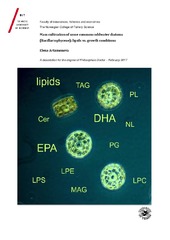| dc.contributor.advisor | Eilertsen, Hans Christian | |
| dc.contributor.author | Artamonova, Elena | |
| dc.date.accessioned | 2017-02-15T14:55:07Z | |
| dc.date.available | 2017-02-15T14:55:07Z | |
| dc.date.issued | 2017-02-27 | |
| dc.description.abstract | The present study was aimed at investigating northern diatoms as sustainable sources of omega-3 fatty acids widely used and now much needed in salmon aquaculture as well as ingredients to be used in nutraceuticals in the human diet.
As known, fish oil is currently the main source of physiologically requisite fatty acids such as eicosapentaenoic (EPA) and docosahexaenoic acids (DHA). Due to the rapid increase of aquaculture production volumes and the world population in the recent decades, the problem of omega-3 lipid deficiency has attracted increased attention the last years. An increase in wild fish catches cannot be considered as the optimal solution to this problem, this since the anthropogenic pressure on the fish populations nowadays is already too high.
In the light of the universally accepted concept of sustainable development (Sustainable development paradigm), it is therefore essential to find completely new, environmentally friendly sources of the omega-3 fatty acids. Northern cold-water microalgae of the diatom group (Bacillariophyceae) are, in this context, potential candidates here due to their high growth rates and phylum- characteristic high content of omega-3 fatty acids, particularly EPA. However, knowledge on diatom lipidome is scarse, even less is known on how different abiotic parameters influence lipogenesis processes in a diatom cell.
Therefore, in the present study the northen cold-water diatoms were investigated in terms of their lipid and fatty acid composition. Besides, the effects of different cultivation parameters (light, temperature, CO2/pH) on lipogenesis were studied.
The results of the current research demonstrated that temperature decrease together with moderate light intensities may trigger accumulation of the polyunsaturated fatty acids (including physiologically requisite EPA) in diatom species. Besides, total lipid content and production of certain PUFAs in a diatom cell may be enhanced by means of CO2 aeration. However, it should be emphasized that the metabolic responses demonstrated by diatoms were highly variable and species - specific. Thus, for the purpose of mass cultivation every single species (and even strain) should be investigated individually. | en_US |
| dc.description.doctoraltype | ph.d. | en_US |
| dc.description.popularabstract | The present study was aimed at investigating northern diatoms as sustainable sources of omega-3 fatty acids widely used and now much needed in salmon aquaculture as well as ingredients to be used in nutraceuticals in the human diet.
As known, fish oil is currently the main source of physiologically requisite fatty acids such as eicosapentaenoic (EPA) and docosahexaenoic acids (DHA). Due to the rapid increase of aquaculture production volumes and the world population in the recent decades, the problem of omega-3 lipid deficiency has attracted increased attention the last years. An increase in wild fish catches cannot be considered as the optimal solution to this problem, this since the anthropogenic pressure on the fish populations nowadays is already too high.
In the light of the universally accepted concept of sustainable development (Sustainable development paradigm), it is therefore essential to find completely new, environmentally friendly sources of the omega-3 fatty acids. Northern cold-water microalgae of the diatom group (Bacillariophyceae) are, in this context, potential candidates here due to their high growth rates and phylum- characteristic high content of omega-3 fatty acids, particularly EPA. However, knowledge on diatom lipidome is scarse, even less is known on how different abiotic parameters influence lipogenesis processes in a diatom cell.
Therefore, in the present study the northen cold-water diatoms were investigated in terms of their lipid and fatty acid composition. Besides, the effects of different cultivation parameters (light, temperature, CO2/pH) on lipogenesis were studied.
The results of the current research demonstrated that temperature decrease together with moderate light intensities may trigger accumulation of the polyunsaturated fatty acids (including physiologically requisite EPA) in diatom species. Besides, total lipid content and production of certain PUFAs in a diatom cell may be enhanced by means of CO2 aeration. However, it should be emphasized that the metabolic responses demonstrated by diatoms were highly variable and species - specific. Thus, for the purpose of mass cultivation every single species (and even strain) should be investigated individually. | en_US |
| dc.description.sponsorship | Norwegian Research council (project 208463) | en_US |
| dc.description | The papers of this thesis are not available in Munin.
<p>
Paper I: Artamonova, E. Y., Svenning, J.B., Vasskog, T., Hansen, E., Eilertsen. H.C.: “ Analysis of phospholipids and neutral lipids in three common northern cold-water diatoms: Coscinodiscus concinnus, Porosira glacialis and Chaetoceros socialis by ultra-high performance liquid chromatography-mass spectrometry”. (Manuscript). Published version available in <a href=http://dx.doi.org/10.1007/s10811-017-1055-0> Journal of Applied Phycology 2017 </a> <p>
Paper II: Artamonova, E.Y., Eilertsen, H.C., Vasskog, T.: “Lipid content and fatty acid composition of Phaeocystis pouchetii, Chaetoceros furcellatus and Thalassiosira nordenskioeldii cultivated at varying light and temperature conditions”. (Manuscript).
<p>
Paper III: Artamonova, E.Y., Vasskog, T., Eilertsen, H.C.: “Lipid content and fatty acid composition of Porosira glacialis and Attheya longicornis in response to carbon dioxide (CO2) aeration”. (Manuscript). | en_US |
| dc.identifier.isbn | 978-82-8266-133-1 | |
| dc.identifier.uri | https://hdl.handle.net/10037/10300 | |
| dc.language.iso | eng | en_US |
| dc.publisher | UiT The Arctic University of Norway | en_US |
| dc.publisher | UiT Norges arktiske universitet | en_US |
| dc.rights.accessRights | openAccess | en_US |
| dc.rights.holder | Copyright 2017 The Author(s) | |
| dc.rights.uri | https://creativecommons.org/licenses/by-nc-sa/3.0 | en_US |
| dc.rights | Attribution-NonCommercial-ShareAlike 3.0 Unported (CC BY-NC-SA 3.0) | en_US |
| dc.subject | VDP::Teknologi: 500::Bioteknologi: 590 | en_US |
| dc.subject | VDP::Technology: 500::Biotechnology: 590 | en_US |
| dc.title | Mass cultivation of some common coldwater diatoms (Bacillariophyceae): lipids vs. growth conditions | en_US |
| dc.type | Doctoral thesis | en_US |
| dc.type | Doktorgradsavhandling | en_US |


 English
English norsk
norsk
